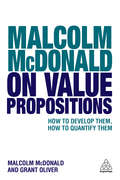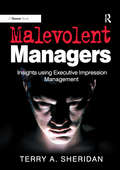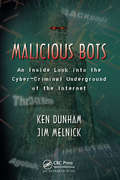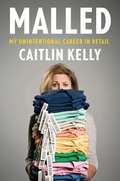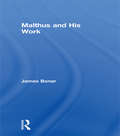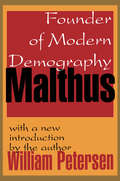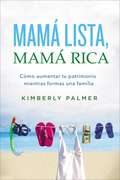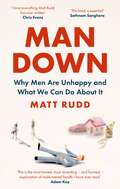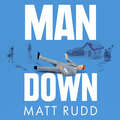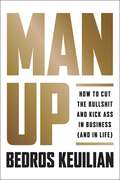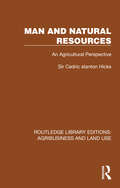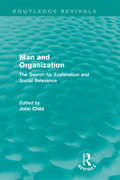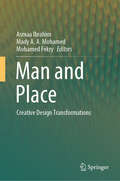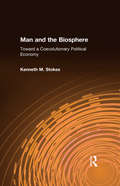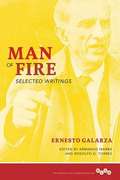- Table View
- List View
Malcolm McDonald on Value Propositions: How to Develop Them, How to Quantify Them
by Malcolm McDonald Grant OliverA value proposition is an innovation or feature that clarifies a company's core purpose and identity. In the same way profit lies at the heart of every business, so does the value proposition, communicating how its service or products fulfill the needs of their customers. While many organizations understand the importance of having a clearly defined value proposition to help them become more profitable, many businesses struggle to use them effectively. Malcolm McDonald on Value Propositions is a step-by-step guide to understanding exactly why financially quantified value propositions will help readers to increase revenue and deliver tangible results.Highly practical and filled with useful tools and checklists, this succinct guide explains the process of developing a value proposition from start to finish, how to use segmentation appeal to the relevant key accounts, and to ensure it is both financially grounded and has resonance with customers. From understanding how buying decisions are made, through to financial dashboards and value quantification tools, Malcolm McDonald on Value Propositions is perfect for anyone looking to integrate financial success into their proposition, and gain understanding of how it can be used to deliver and communicate value.
Malcolm Turner at Vanderbilt
by David G. Fubini James BarnettMalcolm Turner becomes the new athletic director at Vanderbilt University, tasked with increasing athletics-related revenue and improving on-field performance, while maintaining Vanderbilt's academic rigor for student-athletes.
Malden Mills (A)
by Nitin Nohria Bridget Gurtler Thomas R. PiperCEO Aaron Feuerstein of Malden Mills decided to pay idled workers after a massive fire at his mill in 1995. Focuses on the decisions made post-fire and the rebuilding process and eventual bankruptcy of the company. Also outlines creditors' struggle to decide whether to lend Feuerstein additional funds to enable him to regain control of the company after emerging from bankruptcy.
Malden Mills (A) (Abridged)
by Nitin Nohria Thomas R. PiperCEO Aaron Feuerstein of Malden Mills decided to pay idled workers after a massive fire at his mill in 1995. Focuses on the decisions made post-fire and the rebuilding process and eventual bankruptcy of the company. Also outlines creditors' struggle to decide whether to lend Feuerstein additional funds to enable him to regain control of the company after emerging from bankruptcy.
Malenti Strings: Intrapreneurship within FLG, Inc.
by David A. Garvin Rachel GordonThis case follows Jenica Fletcher as she rebuilds her company's guitar strings division from the ground up. Convinced that she could turn the division around if given complete independence from corporate headquarters, Fletcher relocated the group, rebranded it as Malenti Strings, repositioned the guitar strings as high-performance products, and transformed Malenti into a fast-growing, profitable business. The case traces Fletcher's key steps in rebuilding the organization, including the development of a team of committed, interdependent employees. Students learn about Fletcher's values and unique management philosophy, as well as her managerial practices and daily activities. The case also discusses the role and development of the partnerships that helped solidify and grow the business. Coming off its high-end success, Malenti must now decide whether to move into the mid-priced market with a new line of electric guitar strings called True.
Malevolent Managers: Insights using Executive Impression Management
by Terry A. SheridanDr Terry A. Sheridan employs a new and unique theoretical perspective to examine how malevolent, tyrannical and mediocre managers commonly use violence in the workplace, not necessarily physical violence, but bullying, overt and covert emotional abuse - all forms of negative behaviour that are damaging to individuals and organisations. The theoretical basis for the author’s analysis and prescriptions is the new perspective of Executive Impression Management, which stems from Dr Sheridan’s research into the differences between a number of types of executives from their co-workers’ point of view. That investigation developed indicators to identify different negative management types and also helped define what has been called respectful management - the sort exercised by those managers who are good stewards. What makes this book unusual is that it is derived from qualitative research and covers an area where hardly any scholarly work has been produced. The author argues that the research methodology employed has resulted in a better understanding of impression management than has hitherto been possible. It addresses the confusion that often abounds regarding who is a good or bad manager and the fact that we can identify bad management through measures of company or organisational performance, but not how and why it went wrong. It will assist the leadership of organisations to make the right decisions about recruitment and promotion and to identify and challenge poor performance effectively.
Mali: Poverty Reduction Strategy Paper
by International Monetary FundA report from the International Monetary Fund.
Malicious Bots: An Inside Look into the Cyber-Criminal Underground of the Internet
by Ken Dunham Jim MelnickOriginally designed as neutral entities, computerized bots are increasingly being used maliciously by online criminals in mass spamming events, fraud, extortion, identity theft, and software theft. Malicious Bots: An Inside Look into the Cyber-Criminal Underground of the Internet explores the rise of dangerous bots and exposes the nefarious methods of "botmasters". This valuable resource assists information security managers in understanding the scope, sophistication, and criminal uses of bots. With sufficient technical detail to empower IT professionals, this volume provides in-depth coverage of the top bot attacks against financial and government networks over the last several years. The book presents exclusive details of the operation of the notorious Thr34t Krew, one of the most malicious bot herder groups in recent history. Largely unidentified by anti-virus companies, their bots spread globally for months, launching massive distributed denial of service (DDoS) attacks and warez (stolen software distributions). For the first time, this story is publicly revealed, showing how the botherders got arrested, along with details on other bots in the world today. Unique descriptions of the criminal marketplace - how criminals make money off of your computer - are also a focus of this exclusive book! With unprecedented detail, the book goes on to explain step-by-step how a hacker launches a botnet attack, providing specifics that only those entrenched in the cyber-crime investigation world could possibly offer. Authors Ken Dunham and Jim Melnick serve on the front line of critical cyber-attacks and countermeasures as experts in the deployment of geopolitical and technical bots. Their work involves advising upper-level government officials and executives who control some of the largest networks in the world. By examining the methods of Internet predators, information security managers will be better able to proactively protect their own networks from such attacks.
Mallard: How the ‘Blue Streak’ Broke the World Speed Record
by Don HaleThe smooth outline of streamlined A4 Pacific locomotive Mallard is instantly recognisable, an icon of railway history resplendent in blue. Famously reaching a top speed of 126mph on 3 July 1938 on the East Coast main line, this world record for steam locomotives still stands today. Don Hale tells the full story of how the record was broken, from the rivalry of the nineteenth-century London–Scotland speed race, to similarities in Mallard’s futuristic design to the Bugatti car, and the influence of Germany’s nascent Third Reich in propelling the train into an instrument of national prestige. Mallard’s designer, Sir Nigel Gresley, is celebrated as one of Britain’s most gifted engineers. Updated with new appendices and extra photographs, this classic book remains the perfect tribute to one of British technology’s finest hours.
Malled
by Caitlin KellyOne woman's midcareer misadventures in the absurd world of American retail. After losing her job as a journalist and the security of a good salary, Caitlin Kelly was hard up for cash. When she saw that The North Face-an upscale outdoor clothing company-was hiring at her local mall, she went for an interview almost on a whim. Suddenly she found herself, middle-aged and mid-career, thrown headfirst into the bizarre alternate reality of the American mall: a world of low-wage workers selling overpriced goods to well-to-do customers. At first, Kelly found her part-time job fun and reaffirming, a way to maintain her sanity and sense of self-worth. But she describes how the unexpected physical pressures, the unreasonable dictates of a remote corporate bureaucracy, and the dead-end career path eventually took their toll. As she struggled through more than two years at the mall, despite surgeries, customer abuse, and corporate inanity, Kelly gained a deeper understanding of the plight of the retail worker. In the tradition of Nickel and Dimed, Malled challenges our assumptions about the world of retail, documenting one woman's struggle to find meaningful work in a broken system. .
Mallorca and Tourism
by R. J. BuswellIn the popular imagination, Mallorca is the archetypal mass tourism resort, one of the world's pioneers of mass tourism, linking the resources of the Mediterranean to the supply of tourists from northern and western Europe. It is now attempting to better manage the ubiquitous transformational environmental and socio-economic impact of the industry. The book identifies and examines critically the major socio-economic and political forces that have played a significant part in the formation of the industry; the development of tourism as a business and efforts to diversify the tourism product as it move into the uncertainties of the 21st century.
Malthus and His Work
by James BonarFirst Published in 1966. Routledge is an imprint of Taylor & Francis, an informa company.
Malthus: Founder of Modern Demography
by William PetersenThomas Robert Malthus (1766-1834), one of the most influential of modern thinkers, is also one of the most misunderstood. Malthus' Essay on Population is a work that everyone cites but typically without having read it. This book offers a comprehensive and accurate exposition of his thought, integrating his better-known theory on population with his somewhat neglected analysis of economic development and social structure.In Petersen's Malthus both the general reader and the social scientist are given a basis for contrasting Malthus with competing theories. As a background to his exposition, Petersen discusses the trends since Malthus' day in fertility, mortality, and population growth. The book also has an accessible comparison of Malthus' economics with that of his contemporary, David Ricardo, as well as the links to the Keynesian thought of recent time.Petersen also comments on Malthus' stand on birth control, as well as on the rise of the neo-Malthusian movement and its successor in today's less developed countries. The review of both population trends and demographic theory over the past century and a half gives the reader a base from which he can judge in what respects Malthus did, or did not, forecast the future accurately. As Petersen points out, Malthus also influenced the evolutionary theory of Charles Darwin, as well as its offshoot, Social Darwinism. Malthus is an essential work not only for demographers and economists but for anyone interested in intellectual history. The late Robert Nisbet, in his review of the book for the New Republic, called it "the best exposition of Malthus to be found anywhere."William Petersen, Robert Lazarus Professor of Social Demography Emeritus at Ohio State University, is known throughout the profession as a leading demographer. He is also an elegant writer.
Mamá lista, mamá rica: Cómo aumentar tu patrimonio mientras formas una familia
by Kimberly PalmerEste libro explora como las mujeres de hoy manejan los retos financieros y los familiares. Inspirador y práctico, ayuda a las mujeres a crear estrategias sobre cómo criar a sus hijos y a la vez tomar decisiones financieras sabias que las pongas en el camino a la prosperidad.Cada madre conoce las decisiones difíciles que conlleva el tener un hijo, como los gastos familiares y las interminables jornadas de trabajo. ¿Cómo cumples con las demandas que exige la maternidad a la vez que mantienesn tus finanzas y tu carrera bajo control? Este libro explora cómo las mujeres de hoy enfrentan los retos profesionales y los familiares. Escrito por una columnista de finanzas y madre, este libro combina consejos profesionales, estrategias de gastos y ahorros con entrevistas a madres profesionales en varios campos laborales.Inspirador y práctico, este libro ayuda a las mujeres a crear estrategias sobre cómo criar a sus hijos y a la vez tomar decisiones financieras sabias que las pongas en el camino a la prosperidad.
Man Down: Why Men Are Unhappy and What We Can Do About It
by Matt Rudd'The most honest, most revealing - and funniest - exploration of male mental health I have ever read' Adam Kay'Matt Rudd may have written the most important book in a generation' Idle Society'A whole-hearted and important attempt to analyse what has gone wrong for so many men and to make some tentative suggestions for what may help' The Times'This book is essential' Sathnam Sanghera'I love everything Matt Rudd has ever written' Chris Evans'I loved it' Christine ArmstrongOn the surface, men today don't have much to complain about. At work, they still get paid more than women for doing the same jobs. At home, they still shirk most of the unpaid labour. Putting the bins out does not count.Beneath the surface, it's a different story. An alarming number of men end up anxious, exhausted, depressed - and very reluctant to admit they are. Even if they do everything that's expected of them in work, life and fatherhood, genuine happiness is still elusive. By midlife, their levels of stress are higher and their levels of wellbeing are lower - and work-life balance turns out to be just a cruel illusion.The evidence is clear and ironic: the system set up by men for men doesn't work for men either. It is making none of us happy.In Man Down, Matt Rudd takes the long view on this perplexing paradox. Drawing on stories from his own life, and the varied lives of the other men he has interviewed, he goes back to the beginning to consider what makes the modern man - how the seeds of midlife misery are sown in the school playground and cultivated through adolescence and into adulthood. By turns compassionate and provocative, Man Down asks the important question: is midlife unhappiness inevitable? Spoiler alert: it isn't.
Man Down: Why Men Are Unhappy and What We Can Do About It
by Matt Rudd'The most honest, most revealing - and funniest - exploration of male mental health I have ever read' Adam Kay'Matt Rudd may have written the most important book in a generation' Idle Society'A whole-hearted and important attempt to analyse what has gone wrong for so many men and to make some tentative suggestions for what may help' The Times'This book is essential' Sathnam Sanghera'I love everything Matt Rudd has ever written' Chris Evans'I loved it' Christine ArmstrongOn the surface, men today don't have much to complain about. At work, they still get paid more than women for doing the same jobs. At home, they still shirk most of the unpaid labour. Putting the bins out does not count.Beneath the surface, it's a different story. An alarming number of men end up anxious, exhausted, depressed - and very reluctant to admit they are. Even if they do everything that's expected of them in work, life and fatherhood, genuine happiness is still elusive. By midlife, their levels of stress are higher and their levels of wellbeing are lower - and work-life balance turns out to be just a cruel illusion.The evidence is clear and ironic: the system set up by men for men doesn't work for men either. It is making none of us happy.In Man Down, Matt Rudd takes the long view on this perplexing paradox. Drawing on stories from his own life, and the varied lives of the other men he has interviewed, he goes back to the beginning to consider what makes the modern man - how the seeds of midlife misery are sown in the school playground and cultivated through adolescence and into adulthood. By turns compassionate and provocative, Man Down asks the important question: is midlife unhappiness inevitable? Spoiler alert: it isn't.
Man Group plc
by Andre F. Perold Herve DuteilIn 2004, Man Group was the world's largest packager and distributor of investment vehicles tied to hedge funds. The firm had an equity market capitalization of $10 billion and funds under management of $38 billion. Man's offerings spanned a wide range of risk/reward profiles packaged in the form of diversified funds of hedge funds, funds that focused on specific hedge fund styles, and funds that invested in a single hedge fund manager. The company also created structured products that consisted of funds of hedge funds combined with principal protection and leverage. An essential part of the strategy was to grow and maintain a global distribution network. Believers considered Man Group to be at the vanguard of a revolution in the investment management industry, while skeptics thought the hedge fund space had become overcrowded and that it would be hard for Man to scale its business and obtain good investment returns for clients.
Man Jit Singh at Sony Entertainment Television (A)
by Linda A. Hill Dana M. Teppert Allison J. WigenExplores the role of CEO Man Jit Singh and his senior management committee in leading Multi Screen Media Pvt. Ltd. (formerly SET Pvt. Ltd.), a leading television broadcaster in India. Describes Singh's decision to evaluate employees based on values as well as performance, and the management committee's response. Allows for discussion of: 1) the impact of leadership style on team culture, performance, and effectiveness; 2) the challenges of building a values-based organization; 3) the complexities of managing talent in a young industry, particularly within an emerging market; and 4) the final decision by CEO Man Jit Singh and the subsequent actions taken by members of the management committee.
Man Jit Singh at Sony Entertainment Television (B)
by Linda A. Hill Dana M. Teppert Allison J. WigenSupplement to (A) case: Explores the role of CEO Man Jit Singh and his senior management committee in leading Multi Screen Media Pvt. Ltd. (formerly SET Pvt. Ltd.), a leading television broadcaster in India. Describes Singh's decision to evaluate employees based on values as well as performance, and the management committee's response. Allows for discussion of: 1) the impact of leadership style on team culture, performance, and effectiveness; 2) the challenges of building a values-based organization; 3) the complexities of managing talent in a young industry, particularly within an emerging market; and 4) the final decision by CEO Man Jit Singh and the subsequent actions taken by members of the management committee.
Man Up: How to Cut the Bullsh!t and Kick @ss in Business (and in Life)
by Bedros Keuilian"But I can't . . ." "There's no way . . ." "It's impossible . . ." Enough. Get off your ass and make your "someday" goals a priority—today. After years of coaching and consulting hundreds of startup rookies as well as seasoned entrepreneurs, executives, and CEOs, Bedros Keuilian realized that most people who want to start a business, grow an existing business, author a book, make more money, or make a bigger impact usually take the long, slow, painful way to get there . . . and more than 80 percent of entrepreneurs never get to their desired destination or achieve their full potential in business. They treat their dream as if it were merely a hobby and dip their toes in the water, but they never commit to diving in—you get the idea. It's time to cut the bullshit excuses. Everyone has a gift, a purpose. It's your duty to figure out what your gift is and how you're going to share it with the world. Man Up: How to Cut the Bullshit and Kick Ass in Business (and in Life) is your guide to doing exactly that. Keuilian, founder and CEO of Fit Body Boot Camp and known as the "hidden genius" behind many of the most successful brands and businesses throughout multiple industries, will show you how to break out of the sea of mediocrity, get singularly focused on your purpose, and do what it takes—not only to achieve but dominate your goals. With Keuilian's no-nonsense approach in both business and personal spheres, you'll be able to define your purpose and have clarity of vision—and a plan—to make the quantum leap. Whether it's creating and growing a company, leaving a legacy, making a difference, or launching a new brand, you will discover how to use your passion, purpose, and sheer grit to overcome any adversity that attempts to derail your progress. If there's an area of your life in which you need to man up, this book will get you there.
Man and Natural Resources: An Agricultural Perspective (Routledge Library Editions: Agribusiness and Land Use #13)
by Cedric Stanton HicksOriginally published in 1975, yet prophetic in its wisdom this book deals with major aspects of man’s ecological destruction in an industrial framework. As well as discussing the destruction of forests by early civilizations the book examines the rate and extension of environmental deterioration in more recent times and the importance of the integrated ‘feed-back’ controls which maintain stability in the ecosphere of which humankind forms a part. Examining the role of entropy, energy quanta and indeterminacy in overthrowing both science and economic theory, the book provides examples from the 20th Century of the uncontrolled demands for energy and material resources, as well as of increasing toxic hazard in the biosphere.
Man and Organization: The Search for Explanation and Social Relevance (Routledge Revivals)
by John ChildFirst published in 1973, this volume concentrates upon contemporary issues of a theoretical and methodological nature in the study of organizations. The contributors are concerned with contemporary ways of explaining the sociological role of modern organizations and work within them. They cover questions of understanding employee behaviour, of careers, of industrial relations, and of the future of management and organizations as we know them with a thorough examination of prevailing assumptions.
Man and Place: Creative Design Transformations
by Asmaa Ibrahim Mohamed Fekry Mady A. A. MohamedThis book is a result of the 1st ARCH and DESN International Conference (previously Memaryat) Conference held at Effat university on the 8th and 9th of February 2023, and includes chapters dealing with the critical manifestation of “Man and Place” to accommodate and embrace social, economic, and environmental needs within a balanced, integrated system.The book is groundbreaking in that it brings together some of the brightest minds in academia and industry. The book includes a diverse range of contributions from esteemed academics and practitioners and offers a unique platform for thought-provoking discussions and innovative strategies that will help shape the cities of tomorrow.Further chapters include topics such as sustainability and creative transformations, smart cities, environmental resilience, resilient local economies, manufacturing innovations, and smart products. This book will be of interest to decision-makers, architects, interior designers, product designers, urban planners, urban designers, entrepreneurs, educators, and agencies.
Man and the Biosphere: Toward a Coevolutionary Political Economy
by Kenneth M. StokesThis four-part monograph traces the dialectical development of economic thought from the Physiocrats through Marx to the present. It is a broad treatment of the history of intellectual thought that bridges economic and the social sciences on the one hand, with natural science and biology in particular on the other. The author is concerned with systems theory and treats the economy from the perspective of the biophysical thermodynamic dimensions of the economic processes. He closes his analysis with a discussion of organizational theory that relates to the formation of institutions and the issues of freedom in a technically dominated society. The book comes full circle in examining the moral and ethical concerns that first influenced the Physiocrats and other founding fathers of economic science.
Man of Fire: Selected Writings
by Ernesto Galarza Rodolfo Torres Armando IbarraActivist, labor scholar, and organizer Ernesto Galarza (1905-1984) was a leading advocate for Mexican Americans and one of the most important Mexican American scholars and activists after World War II. This volume gathers Galarza's key writings, reflecting an intellectual rigor, conceptual clarity, and a constructive concern for the working class in the face of America's growing influence over Mexico's economic system. Throughout his life, Galarza confronted and analyzed some of the most momentous social transformations of the twentieth century. Inspired by his youthful experience as a farm laborer in Sacramento, he dedicated his life to the struggle for justice for farm workers and urban working-class Latinos and helped build the first multiracial farm workers union, setting the foundation for the emergence of the United Farm Workers Union. He worked to change existing educational philosophies and curricula in schools, and his civil rights legacy includes the founding of the Mexican American Legal Defense Fund (MALDEF) and the National Council of La Raza (NCLR). In 1979, Galarza was the first U.S. Latino to be nominated for the Nobel Prize in Literature, for works such as Strangers in Our Fields, Merchants of Labor, Barrio Boy, and Tragedy at Chualar.
